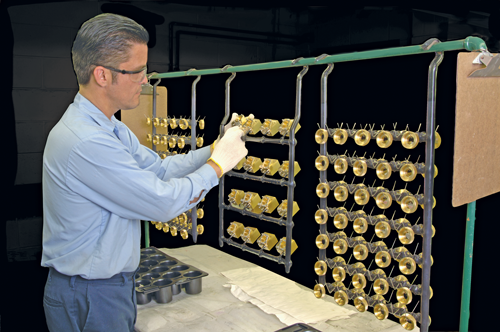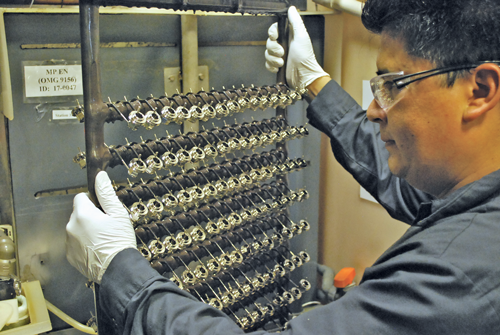Methods and Tooling Design Considerations for Rack Plating
Recognize your unique metal finishing requirements and criteria and reconcile them with the right processes.
Metal finishing is a highly diverse industry that serves the needs of myriad other industries. Although there is always common ground, every industry has its own unique set of needs and criteria for metal finishing. The conscientious metal finisher must be able to recognize these requirements, and reconcile them with the nuances of plating methods and processes.
When quoting a prospective job, some of the key factors to consider are:
Featured Content
• Part geometry
• End use
• Base material
• Part volume (EAU)
• Throughput
• Type of process (electroless, electrolytic, immersion only, etc.)
There is one critical aspect that unites all of the above points: Tooling is one of the most important inputs when we begin to put together a metal finishing solution. Oftentimes, a tooling charge may be incorporated into a quote as an effort to optimize the process at the onset of the job. In the context of metal finishing, tooling is the broad category of hardware required to apply the finish to the part. Tankage, bussing, power supplies, HVAC, plating barrels, plating racks, masking, agitation equipment and material handling equipment can all fall under the umbrella of tooling. Rack plating is a particular area of concern with respect to tooling. Designing an effective plating rack often consumes a large amount of engineering bandwidth during the development of a new job.

Tooling is one of the most important inputs when we begin to put together a metal finishing solution, which includes the proper racking equipment.
Defining Rack Plating
The broad-stroke category of plating that Advanced Plating Technologies performs falls under “loose-piece” plating. This term serves mainly to distinguish from continuous forms of plating, such as reel-to-reel. In loose-piece plating, the goal is to apply the desired finish to an individual part—the “loose piece.” The loose pieces are processed as a load of varying degrees of size, using tools called plating barrels or plating racks. As such, when developing the finishing protocol, the finisher must choose a physical means with which to apply the finish to the loose piece.
There are two principal subcategories of loose-piece plating: barrel plating and rack plating.
Rack plating is a method that involves fixturing individual parts into an array mounted on a solid frame—the plating rack. The plating rack serves the following purposes:
• To physically hold the parts in a secure manner;
• To maintain electrical contact with and to pass DC current to the parts;
• To orient the parts appropriately in accordance with the thickness specifications, part geometry, drainage, gas elimination and quality requirements;
• And to optimize throughput.
Rack plating can be configured to accommodate virtually any part size or geometry. Racks can be made for a single part, or thousands of parts; a rack may be the size of a textbook, or the size of a garage door. In any case, rack plating requires careful consideration of plating process phenomena and the nuances of the part
in question.

Rack plating can be configured to accommodate virtually any part size or geometry, and can be made for a single part or thousands of parts.
Rack Plating and Plating Cell
Electroplating is an electrochemical process. Driven by an external DC power source, metal cations, such as Ni2+, are reduced at the surface of the part (the cathode of the plating cell) to nickel metal (Ni0). The anodes are the sources of new metal ions to replace the ions being plated on to the part. This process involves the physical movement of ions through the plating solution at a rate on the order of 0.01 centimeters per second.
The rate of ion flow can be manipulated by what is referred to in the industry as current density—that is, the ratio of current supplied by the DC power supply to the surface area of the cathode (i.e., the parts being plated). The importance of current density as a metric in the industry cannot be understated, particularly with regard to rack plating. Current density manipulation is often a principal reason for developing a custom rack.
For a given array of parts on a plating rack, the current density is not distributed evenly across the parts; almost without exception, there will be a gradient. The parts around the perimeter of the array would be considered “high current density areas,” meaning they will receive a relatively higher amount of metal deposition than the more interior pieces.
The portion of the part that is toward the interior of the plating cell, rather than facing the anodes, will have less plating buildup—this is a phenomena known as “shielding.” Just as a tree may provide shade from the sun, physical objects between the anode and cathode of the plating cell will shield metal deposition. In addition to shielding, a surface that is facing the anodes will have less plating buildup in holes, recesses, cavities or other internal features. These tendencies can be mitigated through sound rack design. Parts may be oriented on the rack in such a way that critical features are facing the anodes. In more technical applications, a plating rack may even be developed with an auxiliary anode inside the parts to generate the required current density in a hole or other recessed feature.

If the current density is not distributed evenly for a given array of parts on a rack, almost without exception, there will be a gradient.
Conclusion
Rack plating plays a key role in developing effective metal finishing protocols. It is the responsibility of the conscientious metal finisher to recognize the customer’s needs, and to reconcile them with the often-misunderstood idiosyncrasies of the plating process. When considering the factors discussed above, the most appropriate method of processing often reveals itself. Other times, several iterations of trial and error may come to pass before the solution becomes clear.
Regardless, in rack plating it is always advisable to develop a custom tool for the application. This will
ensure that the process is optimized and parts are
being processed in a manner that is consistent with good plating practice.

The portion of the part that is toward the interior of the plating cell, rather than facing the anodes, will have less plating buildup, a phenomena known as “shielding.”
James Lindstedt is a manufacturing and process engineer at Advanced Plating Technologies. For more information, please visit advancedplatingtech.com.
Originally published in the May 2016 issue.
RELATED CONTENT
-
Gold and Silver Plating Basics
An overview of precious metal electroplating processes.
-
Stripping of Plated Finishes
The processes, chemicals and equipment, plus control and troubleshooting.
-
Masking for Surface Finishing
Masking is employed in most any metal finishing operation where only a specifically defined area of the surface of a part must be exposed to a process. Conversely, masking may be employed on a surface where treatment is either not required or must be avoided. This article covers the many aspects of masking for metal finishing, including applications, methods and the various types of masking employed.


















